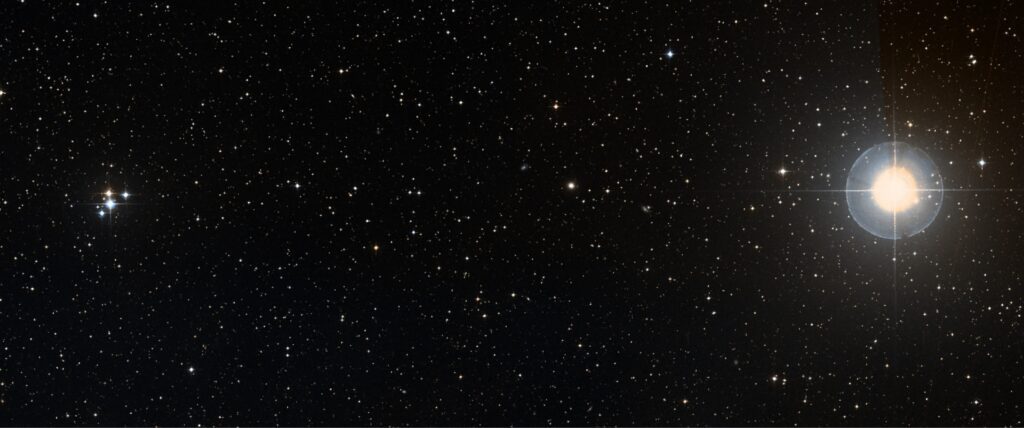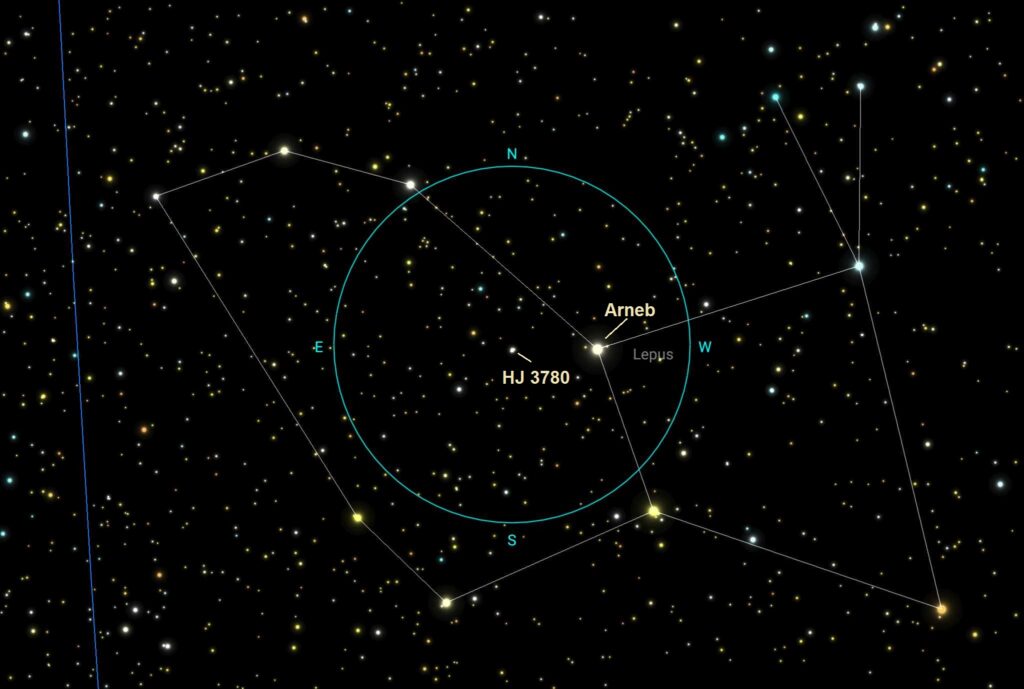

The multiple star HJ 3780 is a colorful and pleasing binocular object in the somewhat neglected constellation of Lepus, crouching just south of Orion. The blazing star in the Simbad image above is Arneb, a 2nd magnitude class F0 1b supergiant, the brightest star in the constellation. Visitors to Lepus are often searching for the winter globular cluster M79 or possibly the famously red Mira-type variable R Leporis, also called Hind’s Crimson Star (in honor of its discoverer), but more about those in other posts.
I came across HJ 3780 in early February last year (2022) and revisited it often in the following weeks. Here is an observation reported in a Cloudy Nights post on 21 March 2022.
HJ 3780
05h39m -17*51′
AC 6.69/8.89 88.8″ pa 137
AE 6.69/7.90 75.4″ pa 9*
AF 6.69/8.25 133.9″ pa 300*
I noticed HJ 3780 because of the deeply orange E component. The four brightest stars are readily seen with the Maven 10×56 and the Oberwerk 15×70 Ultra. A remarkable grouping.
According to Phil Harrington in his superlative Touring the Universe Through Binoculars, the four bright components can be resolved with a 7x binocular. A few evenings later (Friday 25 March 2022) I attempted the observation with a the Maven b.2 7×45, mounted of course, and found it to be somewhat challenging from my suburban yard (Bortle 7 skies). I could see the AB star in direct vision and hold the E and F stars steadily in averted. I couldn’t quite hold the CD star steadily in averted, but could see it 95% of the time or more. This multiple star might be more enjoyable with the 7×45 from a darker site, but from my yard it is better viewed with larger binoculars. And the colors are best seen with binoculars of 80mm aperture or more.

I reobserved the group on Friday 3 March 23 with a Kowa Highlander 82×32, noting colors of orange (e), light blue (ab), and sand (cd, f). The G and I stars could occasionally be glimpsed in averted vision. A fainter h star is to the right (northwest) of the ab primary, too faint to be seen with the 82×32 and not included in this diagram. The ab and cd stars are so labeled because they are double stars although too close (ab 0.5″ and cd 1.5″) to be resolved with typical binocular telescopes.
The group of stars was cataloged as the open cluster NGC 2017, first identified by John Herschel on 11 December 1835, but has since been determined not to be a cluster and thus declared non-existent. And, in fact, it is not a true multiple star, though some of the visible members may be related based on distance evidence, but all pairs (even the closest) are listed as either uncertain or not physical double stars in the Washington Double Star catalog. Not one pair is categorized as definitely a physical double star.
Distances from Earth based on data from Simbad — Gaia Early Data Release 3 (2020yCat.1350).
AB 1037 LY
CD 1076 LY
CD 1018 LY
E 2144 LY
F 494 LY
G 3354 LY
I 2353 LY
If no members are truly related it is certainly a remarkable chance alignment of colorful stars and well worth viewing if one should happen to be roving the star fields of Lepus.


I observed this one a few months ago – I remarked “Hextuplet!!!” [sic] in my log, so it seems I missed out on attempting to split AB and CD. It’s incredible that none of the stars are definitively physical pairs. What are the odds? I’ll have to try this one out with binoculars before Lepus fades into the sunset.
An interesting little group of stars for sure!!
I was able to get AB, CD, E, and F all easily with 15×70 Deluxe but wasn’t able to detect G or I with ’em. Using 25×100 Tachyons I could just faintly get one of them using adverted vision but only a small fraction of the time. The stars were low in the sky and seeing was horrible, plus there was a fairly bright Moon close by at the time. The Deluxe showed a nice orange color to E and slight blue of AB, while the Tachyons brought out the pale yellow F and showed the difference in color between the blue AB and white CD.
This is definitely an object I’ll be coming back to with large binos under better conditions. I’ll also turn a small refractor on it next time to see what higher power will give me.
Well done, Astro. And a fine report!👍🏾